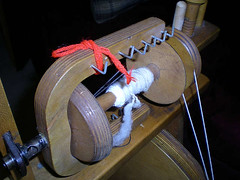 First, you need to determine what the ratio on your wheel is.
First, you need to determine what the ratio on your wheel is.Ratio on a wheel is the ratio of the number of times the flyer goes around (== the number of complete revolutions or twists put into your fiber) to one complete revolution of the drive (big) wheel. Most "slow" whorls on wheels are a 4:1 or 6:1 ratio ... "hi speed" whorls can be anything from 18:1 to 32:1 and up ... charkas are typically at least 20:1, and go up to 100:1 (maybe they should be called "light speed").
The wheel shown in the picture - a Clemes & Clemes wheel - has a ratio of 5.5:1. For each full revolution of the drive wheel, the flyer arm with the red tie on it goes around five and a half times.
 To count the ratio on my wheel, I usually tie a bright piece of yarn to one flyer and count each time it passes through the top of its revolution, while I turn the large drive wheel. Alternatively, you could take a tape measure and measure the diameter of the drive wheel and the flyer whorl -- but accurately measuring the depth of the groove might get tricky.
To count the ratio on my wheel, I usually tie a bright piece of yarn to one flyer and count each time it passes through the top of its revolution, while I turn the large drive wheel. Alternatively, you could take a tape measure and measure the diameter of the drive wheel and the flyer whorl -- but accurately measuring the depth of the groove might get tricky.Yes, charkas don't have flyers -- one complete revolution of the spindle is used in their case, because that puts the twist into the fiber.
The bobbin doesn't go around as quickly/as often as the flyer, esp. with scotch tension -- it has to stop to let the fiber wind onto it. And with double drive, well, I get very iffy there because the bobbin and flyer move at different speeds throughout ... Alden Amos explains it all very thoroughly, I just haven't felt like tackling those pages in his Big Book of Handspinning.
Now, what's the ratio for? Well, this wheel of mine has only one ratio, so it's for everything. And with enough gumption, I could spin fine, high-twist yarn on it. But generally speaking, I'll use lower ratios like this for my thicker, lower-twist yarn.
On my wheels with different ratios, I may move between ratios even with the same spinning -- when I'm starting with a mixed-staple-length blend, I may use a low ratio so I can put twist in more slowly as I figure out what style of drafting works best with the fiber, and then switch to a higher ratio once I've figured out the drafting and am ready to move at a faster clip -- especially if it was the long walk with the dog that morning, or if I managed to shine my shin against the edge of the step again.
So, I use a low ratio for putting in twist more slowly, and a high ratio for putting in twist more quickly. Generally.
That said, you can also use ratios to help you spin a thicker yarn or a finer yarn.
If you want to spin a thicker yarn, move to a lower ratio. Why does this work? For a couple of reasons. The lower ratio will have a wider diameter flyer whorl, which puts the drive band in contact over a larger surface, increasing the draw-in tension on the wheel. The faster the fiber is pulled onto the whorl, the less twist it will have in it. So, all other things being equal, the wider flyer whorl will increase the take-up of your fiber, helping you to spin thicker. There's less time to draft if the take-up speed is increased, and the thicker yarn needs less twist to hang together.
If you want to spin a thinner yarn, move to a higher ratio. This works because it reduces the surface contact area of the drive band with the flyer whorl, reducing the draw-in tension on the wheel. So, you can hang onto the fiber supply a little more easily, keeping it from drawing in, drafting it out a bit finer and getting more twist into it before it goes onto the bobbin.
Now, these last two points on thicker/thinner are in a way, secondary effects -- if you take your default spinning and apply these to it, you will see these effects. There are other techniques that also help you spin thicker and spin finer.
Also, all credit for clarifying this for me goes to the wonderful Judith Mackenzie McCuin, who applied the second technique, among several other nifty tricks, in teaching us to spin sewing machine thread at Madrona ... I almost got there!
For notes on spinning thicker, see tagged SinglesYarn. And for notes on spinning finer, see posts tagged SockSpinning.
Whew! I could go on and on about ratios ... do you want to know ...
Do I move to a higher or a lower ratio to ply?
What ratio do I need on my wheel?
Should I get the high speed whorl?
Should I get the low speed whorl?
Should I get the quill head for my spinning wheel?
How do I spin thicker plied yarns?
Wow, I'm just full of opinions this evening ;-) tell you what ... let me know if there's one there that stands out for you, and I'll move it up my writing list. Thanks!
